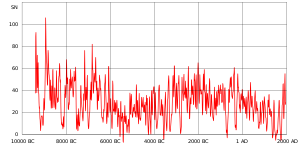
Space climate is the long-term variation in solar activity within the heliosphere, including the solar wind, the Interplanetary magnetic field (IMF), and their effects in the near-Earth environment, including the magnetosphere of Earth and the ionosphere, the upper and lower atmosphere, climate, and other related systems. The scientific study of space climate is an interdisciplinary field of space physics, solar physics, heliophysics, and geophysics. It is thus conceptually related to terrestrial climatology, and its effects on the atmosphere of Earth are considered in climate science.[1][2][3]
- ^ Mursula, K.; Usoskin, I.G.; Maris, G. (January 2007). "Introduction to Space Climate" (PDF). Advances in Space Research. 40 (7): 885–887. Bibcode:2007AdSpR..40..885M. doi:10.1016/j.asr.2007.07.046. ISSN 0273-1177.
- ^ González Hernández, I.; Komm, R.; Pevstsov, A.; Leibacher, J (2014). "Solar Origins of Space Weather and Space Climate: Preface". Solar Physics. 289 (2): 437–439. Bibcode:2014SoPh..289..437G. doi:10.1007/s11207-013-0454-x.
- ^ Lockwood, M.; et al. (2017). "Space climate and space weather over the past 400 years: 1. The power input to the magnetosphere". J. Space Weather Space Climate. 7: A25. arXiv:1708.04904. Bibcode:2017JSWSC...7A..25L. doi:10.1051/swsc/2017019. S2CID 37433045.
© MMXXIII Rich X Search. We shall prevail. All rights reserved. Rich X Search
